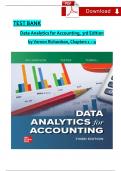Tentamen (uitwerkingen)
TEST BANK For Data Analytics for Accounting 3rd Edition by Richardson, Teeter & Terrell, Chapters 1 - 9, Complete Newest Version
- Vak
- Instelling
- Boek
TEST BANK For Data Analytics for Accounting 3rd Edition by Richardson, Teeter & Terrell, Chapters 1 - 9, Complete Newest Version TEST BANK For Data Analytics for Accounting, 3rd Edition by Vernon Richardson, Verified Chapters 1 - 9, Complete Newest Version Chapter 1: Data Analytics for Accounti...
[Meer zien]




